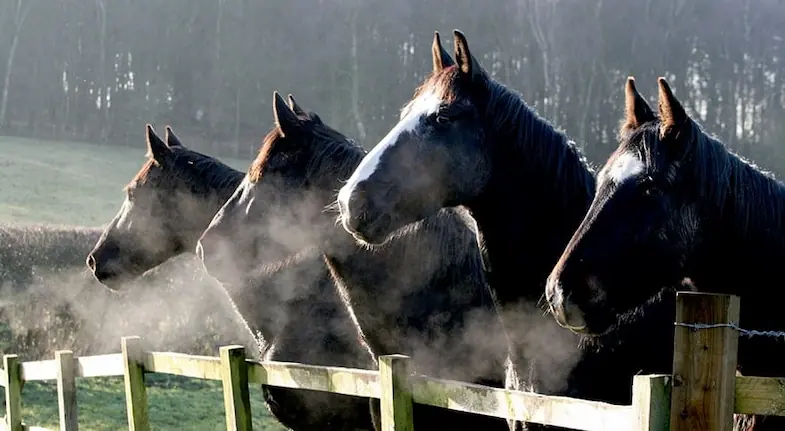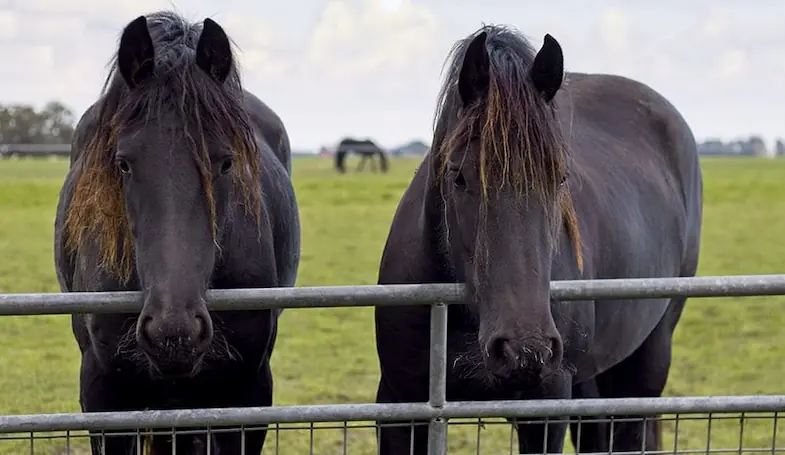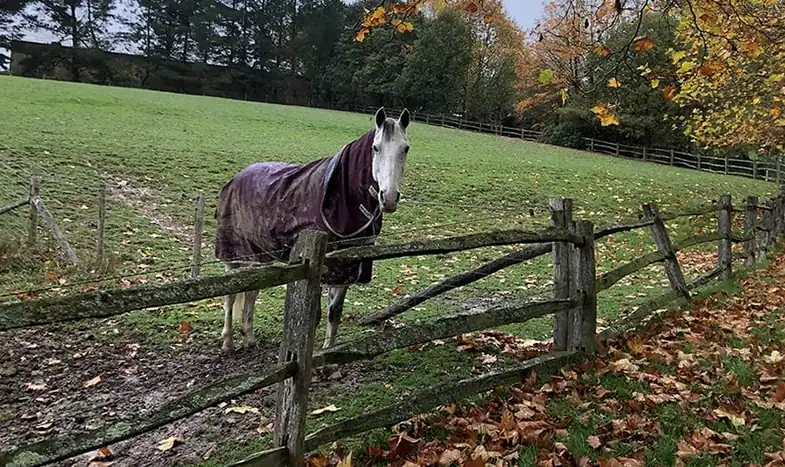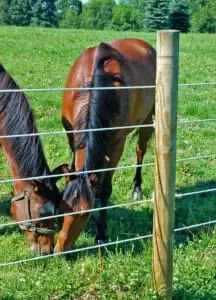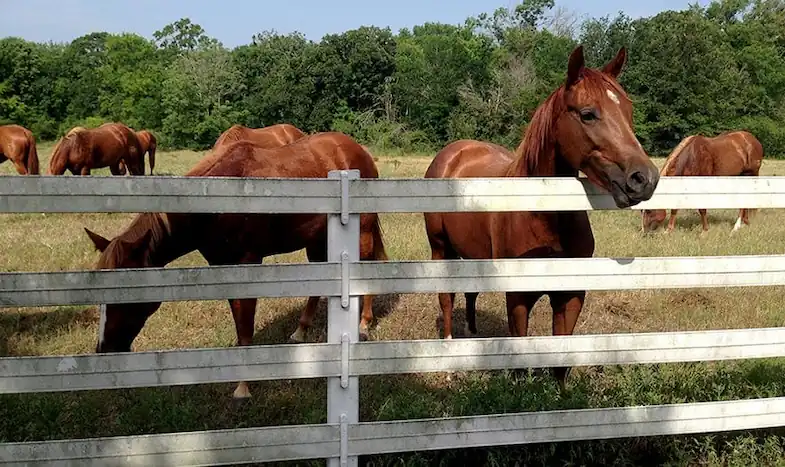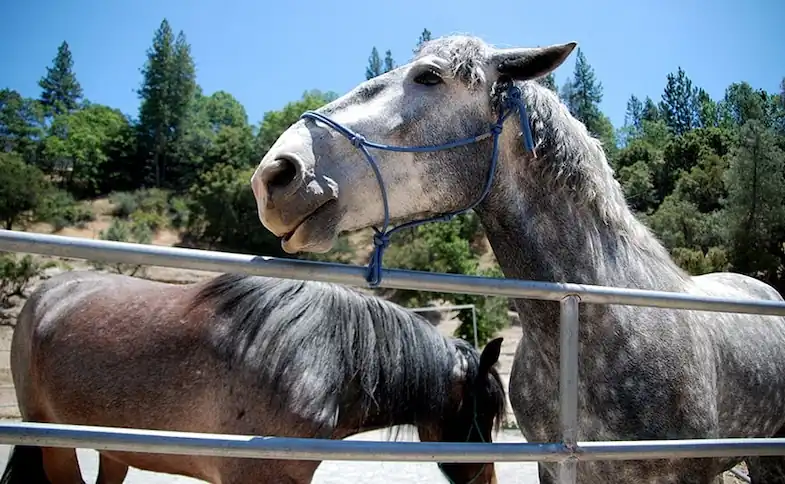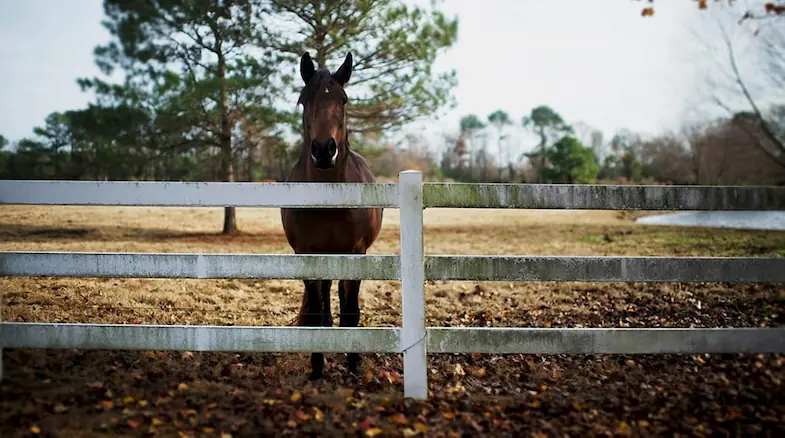Recently one of my horses was a little bit too enthusiastic while relieving a problematic itch and I now need to replace a whole section of fencing. I admit that the fence was in need of serious attention before but now I’d been forced to replace it. While I was going to replace like for like it did start me thinking about the multitude of different fencing options around today. I made the mistake of looking online to research the options available, but nobody seemed to be able to answer my questions about cost and safety. This just left me frustrated so I decided to call some manufacturers to get the answers myself. Armed with the costs, ease of installation, and safety details I decided to write this article, in the hope that other people wouldn’t have to do the research themselves.
The best horse fencing needs to be thick enough so that a horse can easily see it from a distance, strong enough to withstand the strength of a horse, and be high enough to stop a horse from jumping over it. Once you’ve taken all that into account you can start to think about the aesthetics of the fencing.
What should I look for when buying fencing for my horse?
You might be surprised to know that recent archaeological excavations carried out by the University of Exeter in Kazakhstan found that the ancient Botai Culture were ‘containing’ horses as back as 3500BC, yet some 5500 years later we still don’t have a suitable solution that works every time for every horse. This is why installing new fencing (or upgrading your existing fencing) can be difficult, with an almost endless choice of materials it can be hard to know where to start. Before settling on the type of fence you need to consider your requirements, the needs of your horse, your budget, and to some extent your horse’s personality, ie is he an escape artist, inquisitive to the point of being destructive, or will he just except the fence and avoid it.
Safety
Whatever fencing option you choose safety should be by far your most important consideration. It should be strong enough to keep your horse secure, tough enough to withstand the most vigorous of rubbing as well as not have any sharp edges (such as nails or splinters) that could injure your horse. While it’s not always possible you should endeavor to use horse-safe fencing, but how the fence is installed will also play a role in how safe the fence is.
If you’re using any post and rail (or wire) system then you should make sure the smoothest side is facing your horse. This will not only reduce the chance of your horse knocking the rails out but will also mean that there are no sharp nail ends that could harm your horse. The height of the bottom rail should also be somewhere between 8 inches and 12 inches above the ground, this will mean that foals won’t be able to roll under it but neither will an adult horse be able to get a hoof stuck.
If, however, you’re using a mesh fence you need to make sure the gaps are either smaller than 3 inches squared or big enough so that your horse can easily remove his head if he decides to stick it through the gap.
Visibility
While having thin, almost invisible, fencing may look nice and give you a clear and uninterrupted view it can also make it difficult for your horse to see. Of course, your horse will see the fence when he’s close to it but if something spooks him while he’s in the middle of the pasture and he panics he could run straight for the fence without realizing it’s there. And by the time he’s seen it, it’s too late for him to be able to stop.
To reduce the chance of this happening some people place flags or signs at regular intervals along the fencing or install a top rail which the horse can clearly see.
Cost
The cost of any fencing is obviously going to be a factor but as well as the cost of purchasing the materials you will also need to have it installed (unless you’re able to do it yourself) which is normally somewhere between $2 and $6 per linear foot, depending on where you live and the fencing materials you’re using.
If you’re using an electric fence there will also be the ongoing cost of the power (either a monthly cost if your fence is mains powered or batteries if not). Wooden fencing will also need to be repaired and sections replaced from time to time and while this won’t incur regular costs it will still add to the cost of the fence.
The longevity of the fence should also be a consideration, for example, something like steel corral fencing may be expensive to buy but, if properly galvanized it can last well in excess of 30 years.
Installation
The type of fencing you go for, to some extent, determines whether you can install it yourself or if you need to have it installed professionally. Steel pipe is a good example of fencing that is normally only installed by contractors whereas you can easily install something like electric fencing or wire fencing yourself.
The other option you have is to use a fencing contractor to drive the posts into the ground and then install the rest of the fencing yourself. The advantage of this is that they’ll use a rammer to literally ram the posts into the ground, this makes the post more secure because the soil compacts around them. This method means that the fence is stronger and likely to last much longer and will cost less to keep in good condition.
Maintenance
Whatever fencing option you chose there will be some maintenance required. In most cases, this is simply walking the perimeter from time to time looking for any damage but something like wood will need more than an occasional glance. Wooden fences need to be checked regularly for signs of wear and tear such as splinters and loose nails. Some horses also like to chew wooden fence posts or rails so you’ll need to check for this too and replace any damaged posts or rails straightaways – unless of course, you leave it as I did and then have to replace the whole section instead of just one rail!
Suitability
Not all fencing materials are suitable for every horse so it’s important to take this into consideration too. Wood is probably the most popular fencing option but if your horse is a cribber or likes to chew the wood this isn’t going to be the best solution for you. Whereas if your horse likes to squeeze his head into the smallest of gaps then a mesh fence will be perfect for you.
What’s the best fencing for my horse?
No fencing option is suitable for everybody or for every horse which is why it can be difficult to know which is the best one for you. There are so many different fencing options on the market today, each with their own pros and cons.
Once you’ve taken all of the points mentioned above into consideration you’ll then need to think about the type of fencing. In some cases, this will be determined by your budget or what’s available in your area but it’s still important to use a material that meets all of your requirements, as well as being aesthetically pleasing.
If you choose to use any form of wire fencing, regardless of whether it’s electric or not you’ll need to make sure there’s enough tension in the fence. You can do this by placing diagonal posts at corners and at regular intervals, this will support the posts and reduce the chance of them being pulled inwards and ultimately collapsing. The other option for tensioning the fence is to use high-tensile wire. Available in woven, smooth, or braided forms (as well as electric and non-electric), high-tensile wire has already been tensioned so you don’t need to install bracing posts.
Electric
You might not realize it but electric fencing has a dual purpose, as well as being a physical fence that will keep your horse in place it also acts as a psychological deterrent that can be used to discourage a horse from leaning on it or stretching over it. When a horse touches the fence it gets a small shock that makes him think twice about doing that again.
The current in most types of electric fencing is provided by a portable charger that creates a circuit when the upright support rods are placed in the ground. This current is only low but the portableness of the charger and the ease with which the rods are inserted into the ground means that it can be used as permanent or temporary fencing.
Wire
Traditionally electric fences were always made of wire and while it’s still very popular today it can be difficult for horses to see, especially from a distance. Electric wire is by far the cheapest form of electric fencing and, as mentioned before, many people install a top rail or use flags to increase its visibility.
Tape
While electric tape is almost double the price of electric wire it comes in a variety of widths which means that it can easily be seen by horses, even from a distance. The tape itself is made up of poly fibers that have been woven with metal strands to enable it to be electrified.
The disadvantage of electric tape fencing though is that, due to the fact that the fibers are tightly woven, it can be easily damaged in high or heavy winds. If you’re using it with temporary rods rather than fixed posts this can also cause the rods to become loose in the ground, meaning that they’ll need to be moved from time to time.
Braid
When it comes to electric fencing braids generally are the best, especially if you’re able to connect it up to an electrical supply. The reason for this is that has all of the benefits of tape (such as the visibility and the variable widths) but none of the disadvantages of it (high winds won’t damage or loosen a braided fence.
Braided fencing also utilities the power more efficiently, it uses metal conductors to transmit the electricity which is distributed reliably over the entire fence. The only real drawback to this sort of fencing is that, unlike tape, it needs its own electricity supply instead of chargers.
Conductive polymer
If you want a solid-looking fence that has all of the benefits that an electric fence does, conductive polymer is perfect for you. As its name suggests it consists of wires that are covered with a conductive polymer. This provides a lot of rigidity while also making them highly visible to horses. Available in a few different colors the fencing can be difficult to install because you have to make sure you’re not breaking the circuit.
Wire
If you like the idea of wire fencing but don’t want to electrify the fence then there are a number of non-electric wire options. Like electric fencing, you’ll need to either use high-tensile wire or brace the posts at strategic points.
Unlike electric fencing though, wire is only available in thin strands that can be difficult for your horse to see, especially if he panics. Some companies have tried to address this by coloring the wire but you can also use top rails (or rails anywhere on the upper fence) or flag markers.
Smooth
Sometimes referred to as bare wire, it’s a single strand of wire that can be (and often is) strung at various heights along a fence. Even when it’s strung four times it’s still incredibly cheap which, combined with how easy it is to install, is why it’s so popular.
Some people like smooth wire fencing because it offers an uninterrupted view but, while this is a good thing from our point of view, it can make it very difficult for horses to see, especially from a distance.
Coated
Recent advances in PVC coatings have meant that coated wire fences are far more common than they used to be. Like smooth wire fencing, it’s cheap and easy to install as well as being strong and long-lasting. The advantage of coated wire though is that the coating makes them more visible to horses.
Available in a variety of colors (ranging from neon tones to more muted natural colors) they can also range in thicknesses too because multiple strands of wire can be combined together to increase the height.
Barbed
The use of barbed wire as a fencing option is controversial within the horse world, there are those that argue it can cause serious injury while others insist if used properly it’s safe then there are people who, like myself, fall somewhere in-between. I personally feel that it should never be used as a primary fencing option but can be used for a secondary (or outer) fence where the horse can’t actually come into contact with the barbed wire. You might not need an outer fence but if you do, the use of barbed wire can greatly reduce the chances of your horse being stolen.
Like most other wire fencing, barbed wire is relatively cheap and is available as either a single or double-strand wire with sharp barbs at approximately 4 to 5 inch intervals.
Mesh
Mesh fencing might sound like a strange option for fencing but it’s actually a very popular option that’s often used in combination with other options such as post and rail. Available in a variety of different styles it’s often used on the bottom half of a fence to stop horses from putting their heads through in an attempt to eat the grass outside of their pasture.
Mesh fencing is also the best option for blind horses because, unlike post and rail fencing, it will flex if they accidentally run into it.
No-climb
Similar to chicken wire, no-climb fencing has open sections that are no larger than 3 inches by 3 inches. While each section can be spot-welded or brazed (soldered) the best fencing uses knots at each intersection although this does increase the cost of the fencing.
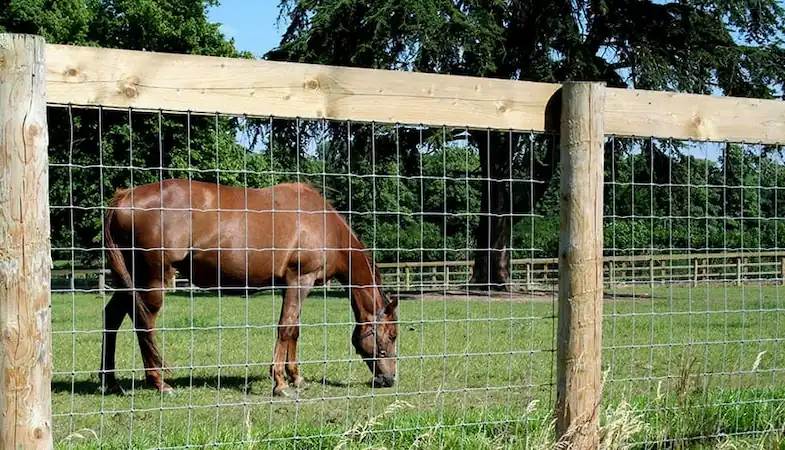
V-Mesh
Very similar to no-climb, v-mesh fencing is woven to create V-shaped openings which make the fence extremely secure and strong. It’s tough enough to absorb the energy of a horse galloping at it (without hurting the horse) although this strength does come at a price (it’s around $2.50 per foot of fencing) but if your horse is a charger then the piece of mind it provides can far outweigh the cost.
Post & Rail
When you think of horses grazing in a field you probably imagine them to be surrounded by post and rail fencing and when you consider this is by far the most common (and the most traditional) type of fencing it’s easy to understand why.
In the past wooden boards were nailed to wooden uprights but, while that’s still a popular choice, these days vinyl and PVC are also used, providing a cheaper option that’s often indistinguishable from wood.
Wood
Many people prefer to use wood fencing because it’s natural and tends to blend in with the landscape as well as being solid and strong enough to keep horses safe. While pine is a popular choice of wood (because it doesn’t split or splinter) it’s also the most expensive option. That said though, location can play a role in the type of wood available, for example, hardwoods are more common in eastern, southern, and midwest states while softwoods are more common in western states.
Another option for wood fencing is pressure-treated lumber (PTL), this is where wood (typically pine or fir) is impregnated with chemicals to prevent rot and fungi. This means that the wood has all of the benefits of pine but at a fraction of the cost. If you choose to use PTL wood though it’s important to use wood that’s been certified for in-ground use.
Despite the aesthetic appeal of natural fencing, it does have a number of drawbacks on top of the cost, not least the fact that some horses have a tendency to chew or eat wooden fencing. It also needs a lot of maintenance, with regular checks being essential to keep on top of any wear.
Vinyl
At a distance vinyl, fencing looks identical to its wooden cousin which is one of the reasons why it’s fast becoming a popular choice with many long-term wooden fence enthusiasts. It’s around two-thirds of the cost of wooden fencing and actually lasts a lot longer (whilst not needing as much maintenance as wood). The problem with vinyl fencing though is that while it doesn’t need as much looking after as wood it’s not as easy to repair with whole planks often needing to be replaced if they’re damaged.
PVC board
Like vinyl fencing, PVC board is a cheaper alternative to wood that is more durable and requires less maintenance although (just as is the case with vinyl) it can be costly to repair. The boards are available in a huge range of colors or can be painted to look like wood but because they’re designed to break on impact it’s not suitable on it’s own. Many owners choose to use PVC boards with at least one line of electric wire, this way the electric part of the fence will keep the horse away while the PVC board will make the fence highly visible, no matter how far away the horse is.
Steel
While many of us are happy to use steel gates it’s a material that is often overlooked for the whole fence yet it’s probably the strongest of all options on the market today. It may not be the cheapest but if you opt for steel sections (corral) then it’s super quick and easy to install and can also be quickly moved so is good for temporary fencing.
Steel is also highly visible which means that there’s no chance of horses not seeing it, but its rigidity means that if a horse does run into the fence it could hurt itself because it’s not designed to flex at all.
Pipe
Steel pipes may be cheap to buy but, unless you’re going to do it yourself, the installation can prove costly. The reason for this is because they need to be measured precisely before being cut to size then welded together.
Corral
Unlike steel pipes, corral fencing doesn’t need professional installers which is one of the reasons why it’s around half the price. The ease with which it can be put together is one of the reasons why it’s a popular choice, especially if you’re looking for temporary fencing that can be quickly erected as well as taken down and installed elsewhere.
When buying corral fencing it’s important to do so from a reputable company that will galvanize it properly. This will help to prolong the lifespan of the fence, increasing it to around 30 years depending on the weather.
Combined fencing
Don’t worry if you can’t find a fencing material that suits you and your horse perfectly, this is actually far more common than you might realize and is why many people choose to use a combination of materials. You can use an electric wire in conjunction with a post and rail fence to give your horse that psychological deterrent or you might want to use no-climb fencing at the bottom and a conductive polymer at the top.
For added security, and to deter would-be thieves, some people use barbed wire as a secondary fence behind the main fence. This means that horses can’t get to it but it’s also more difficult for the wrong people to get in.
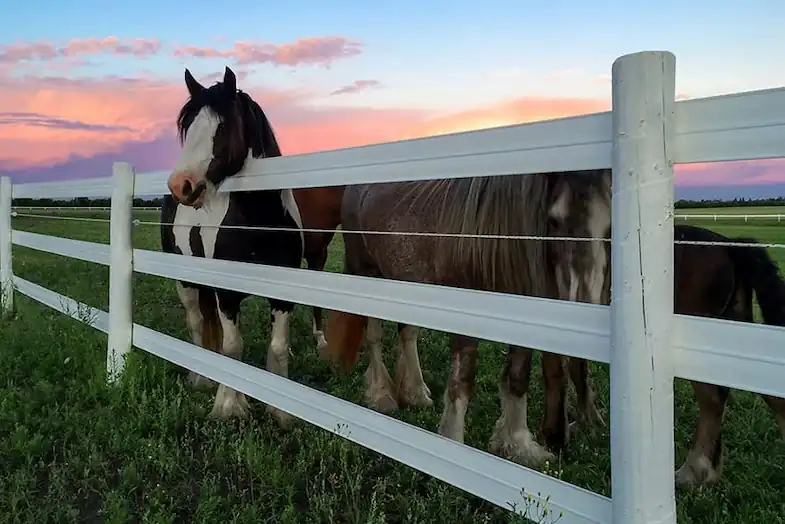
How much does horse fencing cost?
While the initial cost of installing fencing is often the main consideration many people overlook the maintenance costs as well as how often the fence will need to be repaired and/or replaced, yet to some extent this is even more important. After all, if fencing is dirt cheap to install but needs to be replaced completely every year then in the long run it’s not going to be so cheap. The same also applies to braided electric fencing, while it may be relatively inexpensive to install the electrical bills can soon add up.
| Fencing Type | Average cost | Longevity | Ongoing costs | Maintainance |
| Wire (4 strand electric) | $0.39 per foot | 20 years | Yes – electricity | Occasional |
| Tape (4 strand electric) | $0.72 per foot | 30+ years | Yes – electricity | Occasional |
| Braids (4 strand electric) | $0.72 per foot | 25+ years | Yes – electricity | Occasional |
| Conductive Polymer (4 strand electric) | $0.52 per foot | 20 years | Yes – electricity | Occasional |
| Smooth Wire (4 strand) | $0.52 per foot | 20 years | No | Occasional |
| Coated Wire (4 strand) | $0.52 per foot | 20 years | No | Occasional |
| Barbed Wire (4 strand) | $0.16 per foot | 20 years | No | Occasional |
| No-Climb | $1.65 per foot | 25+ years | No | Occasional |
| V-Mesh | $2.42 per foot | 25+ years | No | Occasional |
| Wooden Rail (4 rail) | $24 per foot | 15 years | Yes – occasional rail replacement | Check, replace and repair when needed |
| Vinyl Rail (4 rail) | $16.50 per foot | 20 years | No | No |
| PVC Board (4 rail) | $16.50 per foot | 15 years | No | No |
| Steel Pipe (3 pipe) | $25.50 per foot | 20 – 30 years | No | No |
| Steel Corral (6 foot section) | $75 per section | 20 – 30 years | No | No |
| Steel Corral (12 foot section) | $200 per section | 20 – 30 years | No | No |
Related questions
How tall should horse fencing be?
As a general rule horse fencing should be somewhere between 4.5 feet and 5 feet high, this normally is high enough to prevent most horses from escaping. If, however, your horse is a champion showjumper or escapologist you might want to increase the height to around 6 feet.
Is field fencing okay to use for horses?
You might think that any fence that’s been made for use around fields is okay for horses but field fencing (or box wire as it’s sometimes called) is unsafe and dangerous for horses. This is, in part, because the openings of the fence are too big which allows horses to easily put their hoof through.
Further reading
- Finding the perfect boarding yard
- What’s the best dust-free bedding?
- Preventing your horse’s stall rest blues
- Keeping a hard keeper on a budget
- How to feed a horse without pasture
- Preparing your horse for winter
- Do horses need to be stabled at night?
- Protect your horse from mosquitoes
- Can horses live outside all year?
- When should you be clipping your horse?
I hope you found this article helpful. If you did I’d be grateful if you could share it please as it would really help me.
Recommended products
Over the years I have tried hundreds of different horsey products, from various blankets and halters to different treats. Some I’ve loved, others I’ve hated but I thought I’d share with you my top all-time favorite products, the ones I never leave the yard without. I’ve included links to the products (which are in no particular order) that I really think are great.
- Horse Knots by Reference Ready – If you’re like me and enjoy pocket reference guides then you’ll love this knot tying guide. These handy cards can easily fit in your pocket or attach to the saddle for quick reference. They’re waterproof, durable and are color coded to make them easy to follow.
- Mane ’n Tail Detangler – Even if you never show your horse you’ll need to detangle his tail from time to time (and possibly his mane too) which is always a challenging chore! I’ve found that if I run a little bit of detangler through my horse’s tails every few days it stops them from getting matted up and makes combing them easy, even if they’re coated in mud. I don’t know if I should admit to this or not but it also works wonders on my hair.
- TAKEKIT Pro clippers – Over the years I’ve tried a lot of different clippers and while some were obviously better than others I found these to be by far the best. They are heavier than a lot of other clippers but for me, that’s a good thing, it makes them feel more sturdy and hardwearing. On top of that they have a range of speeds so are just as good for clipping your horse’s back as they are his face. I also like the fact that they come in a handy carry case but that’s not for everybody. The company that makes them is super good and incredibly helpful too, a real bonus these days. The only thing I wasn’t keen on was the fact that it doesn’t come with any oil, but that’s not a major problem as it’s not difficult to buy lubricant.
- Shire’s ball feeder – There are so many boredom buster toys out there but I like to use these every day, regardless of whether or not my horses are bored. I find that it helps to encourage my horses to problem solve by rewarding them with treats (or pieces of fruit) but it also mimics their natural grazing behavior which helps to keep them calm and de-stressed.
- Horse safe mirror – This is a strange one that many people are surprised about but I like to put horse safe mirrors in the trailers as well as in the quarantine stalls. It helps to prevent the feeling of isolation by giving the impression of other horses being around. Being herd animals horses can get extremely stressed when they feel that they’re on their own but with these stick-on mirrors, they believe that at least one other horse is with them.
- Rectal thermometer – I know this isn’t glamourous at all but it’s vital for your horse’s well-being to be able to check their temperature and a rectal thermometer is the easiest way of doing this which is why I’ve added it to the list.
Shopping lists
I’ve also put together a few shopping lists of essential items that I’ve found helpful over the years. I’ve broken the lists down into different categories rather than put everything in one massive list 😉

